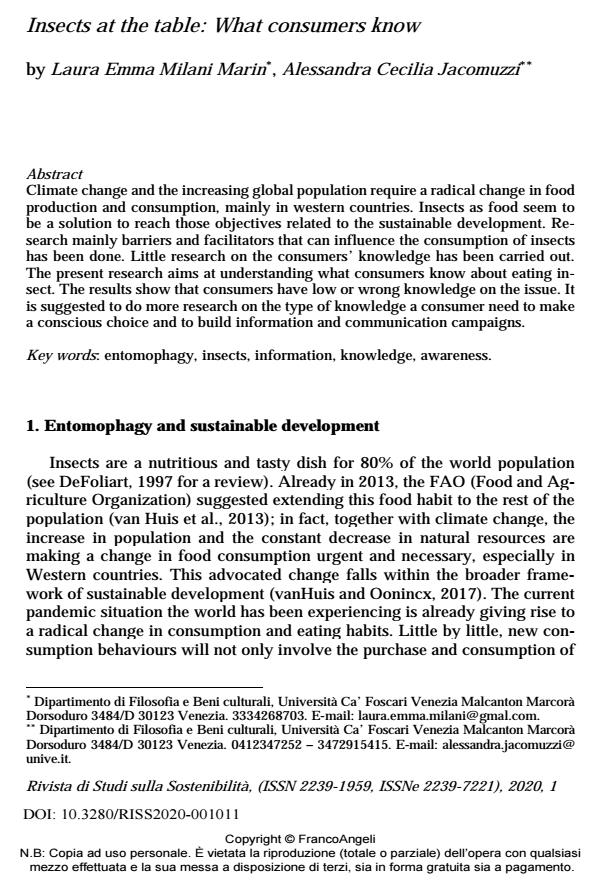Insects at the table: What consumers know
Journal title RIVISTA DI STUDI SULLA SOSTENIBILITA'
Author/s Laura Emma Milani Marin, Alessandra Cecilia Jacomuzzi
Publishing Year 2020 Issue 2020/1
Language English Pages 14 P. 195-208 File size 121 KB
DOI 10.3280/RISS2020-001011
DOI is like a bar code for intellectual property: to have more infomation
click here
Below, you can see the article first page
If you want to buy this article in PDF format, you can do it, following the instructions to buy download credits

FrancoAngeli is member of Publishers International Linking Association, Inc (PILA), a not-for-profit association which run the CrossRef service enabling links to and from online scholarly content.
Climate change and the increasing global population require a radical change in food production and consumption, mainly in western countries. Insects as food seem to be a solution to reach those objectives related to the sustainable develop-ment. Research mainly barriers and facilitators that can influence the consump-tion of insects has been done. Little research on the consumers’ knowledge has been carried out. The present research aims at understanding what consumers know about eating insect. The results show that consumers have low or wrong knowledge on the issue. It is suggested to do more research on the type of knowledge a consumer need to make a conscious choice and to build information and communication campaigns.
Keywords: Entomophagy, insects, information, knowledge, awareness.
- Neuromarketing and Sustainability: Understanding Implicit Bias to Promote Sustainable Eating Habits Alessandra Cecilia Jacomuzzi, Christine Mauracher, Eleonora Brotto, in RIVISTA DI STUDI SULLA SOSTENIBILITA' 1/2025 pp.33
DOI: 10.3280/riss2025oa19243 - Psychology and cognitive sciences: Past, present and future Alessandra Cecilia Jacomuzzi, Tommaso Vecchi, Sonia Paternò, in RICERCHE DI PSICOLOGIA 4/2025 pp.49
DOI: 10.3280/rip2024oa19170 - Insects as food: Knowledge, desire and media credibility. Ideas for a communication Laura Emma Milani Marin, Jeremy Oscar Smith Pezua Sanjinez, Alessandra Cecilia Jacomuzzi, in RIVISTA DI STUDI SULLA SOSTENIBILITA' 2/2022 pp.385
DOI: 10.3280/RISS2021-002025
Laura Emma Milani Marin, Alessandra Cecilia Jacomuzzi, Insects at the table: What consumers know in "RIVISTA DI STUDI SULLA SOSTENIBILITA'" 1/2020, pp 195-208, DOI: 10.3280/RISS2020-001011